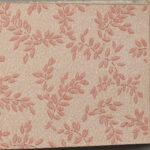Walter Gropius, a noted pioneer of modern architecture, founded the Bauhaus in 1919 in Weimar, Germany. The school focused on architecture, design, crafts and art with the goal of imbuing students with an understanding of the arts and craftsmanship. Students at the Bauhaus trained in workshops that provided practical, hands-on experience across disciplines. The workshops stressed collaboration with industry and the production of high-quality items that could be mass-produced and sold at a reasonable price. The most commercially successful products to come out of the Bauhaus workshops were the wallpapers designed in the mural-painting workshop.
Bauhaus  wallpapers were not “patterned” in the traditional sense but had mottled, flecked, and combed markings and textured effects. They were designed to be understated, and appropriate for use in new large-scale housing developments that were being built at the time. The German wallpaper firm Rasch originally had an exclusive contract with the Bauhaus to produce its wallpapers, but the influence of this “Bauhaus-Tapeten” rippled throughout the wallpaper market of the 1930s and beyond.
wallpapers were not “patterned” in the traditional sense but had mottled, flecked, and combed markings and textured effects. They were designed to be understated, and appropriate for use in new large-scale housing developments that were being built at the time. The German wallpaper firm Rasch originally had an exclusive contract with the Bauhaus to produce its wallpapers, but the influence of this “Bauhaus-Tapeten” rippled throughout the wallpaper market of the 1930s and beyond.
 This wallpaper sample book, Weimar-Bauhaus u. andere Tapeten, or “Weimar-Bauhaus and other wallpapers,” can be seen as evidence of that ripple effect. Published in 1934 (one year after the close of the Bauhaus), the book contains 164 samples of Bauhaus-inspired wallpapers and other “modern designs” showing colored and textured patterns and geometric and floral prints. The pricing information on the inside of the front cover includes a logo in the shape of a key with the text “Tapeten, Teppiche, Linoleum, Stoffe, H.[F?]. von Wittgenstein, 1838,” and informs customers of “Improved quality! – Cheaper prices!”
This wallpaper sample book, Weimar-Bauhaus u. andere Tapeten, or “Weimar-Bauhaus and other wallpapers,” can be seen as evidence of that ripple effect. Published in 1934 (one year after the close of the Bauhaus), the book contains 164 samples of Bauhaus-inspired wallpapers and other “modern designs” showing colored and textured patterns and geometric and floral prints. The pricing information on the inside of the front cover includes a logo in the shape of a key with the text “Tapeten, Teppiche, Linoleum, Stoffe, H.[F?]. von Wittgenstein, 1838,” and informs customers of “Improved quality! – Cheaper prices!”



